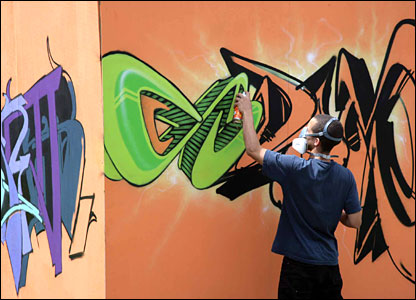Before embarking on Graffiti Painting, one should be aware that there is a thin line between vandalism and graffiti. Only when one is safely on the right side of the law, should any kind of creative liberty be assumed through Graffiti Painting.
Painting Graffiti is an art of big scale. Its grandeur is enhanced by the size of the image. Stark and bold colors, along with the fonts, those themselves are an art form of their types. These are the hallmarks of Graffiti Painting.
Steps for Graffiti Painting.
Subject. Choose the subject for your graffiti painting and starkly demarcate the shadow areas. Graffiti painting works only when one has clear chiaroscuro effect. Draw a small-scale image of the subject of your graffiti, taking care that there is not too much detailing. Subjects for beginners should appropriately be inspired from the artwork in comics. The fonts and rendering in comics make for a great beginners' work.
Coloring. Once you have outlined your graffiti sketch on a small scale, its time to fill in colors and imagine the entire work on a large scale. What looks awesome on small size, does not essentially translate into a large-scale graffiti work, neither is there a foolproof way to judge that. However, its this uncertainty only that makes the process of Painting Graffiti an evolutionary one.
Outlining Work Area. Outline your Graffiti work area into a rectangle, using charcoal or white diluted paint. You can use a string to mark out a rough grid on the work area. Using charcoal, transfer the small-scale model onto the work surface.
Background. Once you are done with outlining the work surface, spray a diluted neutral colored paint (White or Pale Cream) using aerosol can on the large areas of your Graffiti Painting, which are to be painted with dark colors. You may also use Paint Rollers to fill in symmetrical areas with colors. Make sure to spread a very thin layer of paint initially. The painted area should be left to dry for at least an hour.
Coloring. Using aerosol cans filled with different colors, start with large areas of your Graffiti Painting, and move on slowly to small areas. Do not let the can's nozzle linger on for more than three seconds at one place, as this would lead to the dripping of paint (of course, if that's the effect you want then carry on the drip way).
Fine Defining. Use fine brush and paint (preferably Emulsion) to bring out the fine lines and the effects of your graffiti painting.
Preservation. If you want some longevity for your graffiti painting, spray it with a thin layer of varnish. You are done with your graffiti painting.
One very important fact of graffiti painting is its idea, its central motive. If you are not excited by an idea or by the colors, or by drawing the initial sketch, it's suggested that you do not venture into this activity. Art without madness is no fun!












Tidak ada komentar:
Posting Komentar